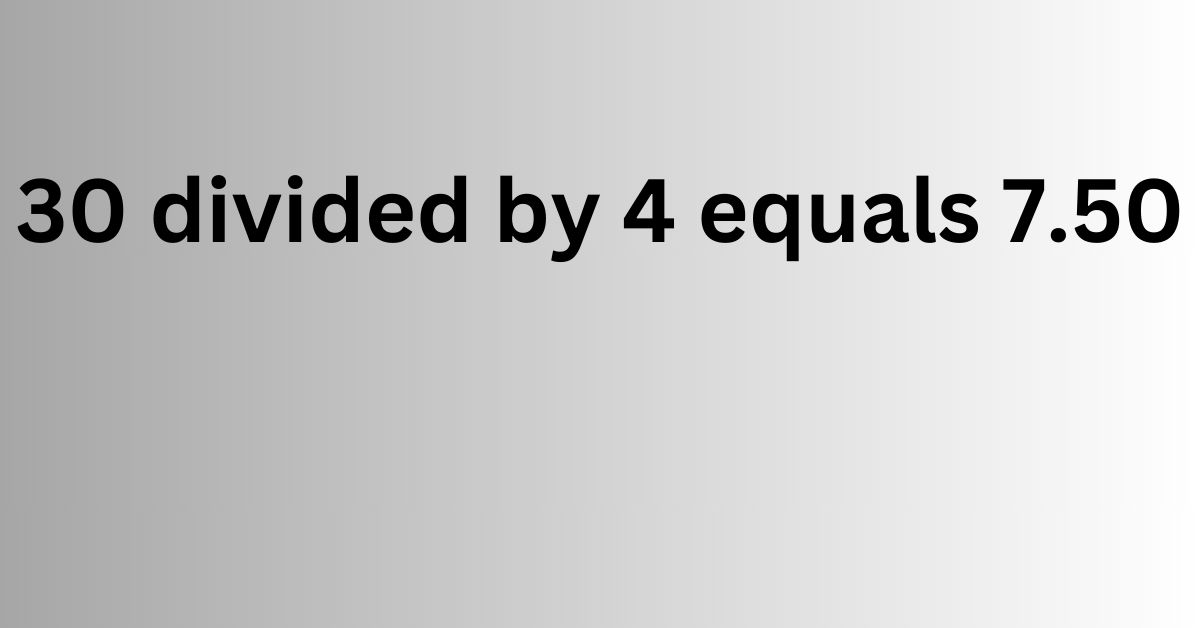Ever scratched your head over a simple division problem? You’re not alone. Let’s dive into the world of numbers and tackle a common calculation: 30 divided by 4. It might seem straightforward, but there’s more to it than meets the eye. We’ll break it down, explore the components, and even look at similar divisions to give you a well-rounded understanding.
What is 30 divided by 4?
When you’re faced with dividing 30 by 4, you might wonder about the best way to approach it. The quick answer? 30 divided by 4 equals 7.5. But let’s not stop there. This result can be expressed in different ways:
As a decimal: 7.5 As a fraction: 30/4 As a percentage: 750%
Each representation has its use, depending on the context. Whether you’re splitting a bill or calculating ingredients for a recipe, knowing these variations can come in handy.
The dividend and divisor of 30 divided by 4
To truly grasp this division, let’s break it down into its parts. In any division, you’ve got two key players: the dividend and the divisor. Think of it as a mathematical story where each number has a role to play.
In our case, 30 is the dividend – it’s the number we’re dividing up. The 4 is our divisor – it’s doing the dividing. Together, they create the problem we’re solving. Understanding these roles helps make sense of more complex divisions down the road.
What is the quotient and remainder of 30 divided by 4?
Now, let’s get to the meat of the matter – the result. When we divide 30 by 4, we get a quotient of 7 with a remainder of 2. But what does that really mean?
The quotient (7) tells us how many whole groups of 4 we can make from 30. The remainder (2) is what’s left over – the amount that doesn’t fit neatly into those groups. This concept of remainders is crucial in many real-world scenarios, from distributing resources to understanding fractions.
Understanding remainders in everyday life
Remainders aren’t just mathematical concepts – they pop up in daily life more often than you might think. Imagine you’re dividing 30 cookies among 4 friends. Each friend gets 7 cookies, with 2 left over. Those 2 extra cookies? That’s your remainder in action.
This practical application of division and remainders helps bridge the gap between abstract math and real-world problem-solving. It’s not just about numbers on a page; it’s about making sense of the world around us.
The importance of divisibility
When we talk about 30 divided by 4, it’s worth noting that 30 isn’t perfectly divisible by 4. But it is divisible by other numbers. Specifically, 30 is divisible by 1, 2, 3, 5, 6, 10, 15, and 30.
Why does this matter? Understanding divisibility can help with quick mental math, problem-solving, and even in fields like computer science where efficient algorithms often rely on divisibility rules.
Using a division calculator: Pros and cons
In today’s digital age, division calculators are at our fingertips. They’re quick, convenient, and eliminate human error. But should we always rely on them?
While calculators are great tools, understanding the process behind division is crucial. It develops critical thinking skills and helps in estimating results – a handy skill when you don’t have a calculator handy.
Similar divisions: Expanding your understanding
To solidify your grasp on division, it’s helpful to look at similar problems. Let’s consider some divisions related to 30:
30 by 6 = 5 (no remainder)
30 by 2 = 15 (no remainder)
30 by 5 = 6 (no remainder)
30 by 3 = 10 (no remainder)
Comparing these to our original problem (30 by 4) helps illustrate how different divisors affect the outcome. It’s a great way to build your division intuition.
Practical applications of division skills
You might wonder, “When will I ever use this?” The truth is, division skills crop up in countless everyday situations. From splitting bills at restaurants to understanding sale percentages, these math basics are more useful than you might think.
Developing strong division skills can help you make quicker decisions, understand financial concepts better, and even improve your critical thinking. It’s not just about passing math class – it’s about equipping yourself with life skills.
Read More Blogs On: trendyloams
Conclusion: Mastering division one problem at a time
We’ve journeyed through the ins and outs of 30 divided by 4, but this is just the beginning. Each division problem you encounter is a chance to sharpen your skills and deepen your understanding.
Remember, math isn’t about memorizing formulas – it’s about understanding concepts and applying them to real-world situations. So next time you’re faced with a division problem, don’t just reach for the calculator. Take a moment to think it through. You might surprise yourself with how much you’ve learned.
Keep practicing, stay curious, and watch as the world of numbers unfolds before you. After all, in the grand equation of life, understanding math is always a plus!

Hello, I’m Scarlett Autumn an author at Trendyloams.com, specializing in Business, Tech, Lifestyle, and News. My writing offers insightful analysis and engaging content, covering a wide range of topics. With a talent for simplifying complex concepts, I ensure my work is both accessible and thought-provoking. Follow me on Trendyloams.com for fresh perspectives and the latest updates on what’s shaping the world of business, technology, and beyond.

